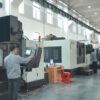Metal heat treatment is one of the essential processes in machinery manufacturing. Compared with other processing processes, heat treatment generally does not change the workpiece’s shape and overall chemical composition but modifies the workpiece’s microstructure or the workpiece’s chemical composition. It is characterized by improving the intrinsic quality of the workpiece, which is generally not visible to the naked eye.
The heat treatment process generally includes three functions heating, heat preservation and cooling, and sometimes there are only two processes of heating and cooling. These processes are interconnected and uninterrupted. Metal heat treatment process can be roughly divided into overall heat treatment, surface heat treatment, local heat treatment and chemical heat treatment.
- Overall heat treatment
The overall heat treatment is a metal heat treatment process that heats the workpiece and then cools it at an appropriate rate to change its general mechanical properties. The comprehensive heat treatment of steel generally has four basic processes: annealing, normalizing, quenching and tempering. Among them, quenching and tempering are closely related and are often used together.
- Annealing
Heating the workpiece to an appropriate temperature, using different holding times according to the material and workpiece size, and then slowly cooling, the purpose is to make the internal structure of the metal reach or close to a balanced state, obtain good process performance and performance, or for further quenching.
- Normalizing
The workpiece is heated to a suitable temperature and then cooled in air. The normalizing effect is similar to annealing, but the obtained structure is more delicate. It is often used to improve the cutting performance of low carbon materials and is sometimes used as final heat treatment for some less demanding parts.
- Quenching
After the workpiece is heated and kept warm, it is rapidly cooled in a quenching medium such as water, oil, other inorganic salts, and organic aqueous solutions. After quenching, the steel becomes complicated but, at the same time, becomes brittle.
- Tempering
The quenched steel parts are kept at an appropriate temperature higher than room temperature but lower than 650 ° C for a long time and then cooled.
The four processes of annealing, normalizing, quenching and tempering have evolved into different heat treatment processes with different heating temperatures and cooling methods. The process of combining quenching and high-temperature tempering is called quenching and tempering. After some alloys are quenched to form a supersaturated solid solution, they are kept at room temperature or a slightly higher appropriate temperature for a long time to improve the hardness, strength or electrical and magnetic properties of the alloy. Such a heat treatment process is called ageing treatment.
The method of combining pressure deformation and heat treatment effectively and closely so that the workpiece can obtain good strength and toughness is called deformation heat treatment; heat treatment in a hostile pressure atmosphere or vacuum is called vacuum heat treatment. It can not only make the workpiece not oxidized and decarburized, keep the surface of the workpiece smooth and clean after treatment, and improve the performance of the workpiece but also can conduct chemical heat treatment through an infiltrating agent.
- Surface heat treatment
A metal heat treatment process that only heats the workpiece’s surface to change the surface’s mechanical properties. To heat only the surface layer of the workpiece without transferring too much heat into the workpiece, the heat source must have a high energy density. That is to say, a more significant amount of thermal energy is given to the workpiece per unit area so that the surface or part of the workpiece can reach a high temperature in a short time or instantaneously. The main methods of surface heat treatment are flame quenching and induction heating heat treatment. Commonly used heat sources are flames such as oxyacetylene or propane, induced current, laser and electron beam.
- Chemical heat treatment
It is a metal heat treatment process by changing the workpiece surface’s chemical composition, structure and properties. The difference between chemical heat treatment and surface heat treatment is that the latter changes the chemical composition of the workpiece surface. Chemical heat treatment is to heat the workpiece in a medium (gas, liquid, solid) containing carbon, nitrogen or other alloying elements for a long time so that the surface of the workpiece is infiltrated with features such as carbon-nitrogen, boron and chromium. After the parts are injected, other heat treatment processes such as quenching and tempering are sometimes carried out. The main methods of chemical heat treatment are carburizing, nitriding, and metalizing.
Heat treatment is one of the critical processes in the manufacture of mechanical parts and injection molds. It can control various properties of the workpiece, such as wear resistance, corrosion resistance, magnetic properties, etc. It can also improve the structure and stress state of the blank to facilitate various cold and hot processing. For example, after long-term annealing treatment of white cast iron, malleable cast iron can be obtained to improve plasticity; gears adopt the correct heat treatment process, and the service life can be doubled or dozens of times higher than that of bags without heat treatment; Some alloying elements have some expensive alloy steel properties and can replace some heat-resistant steels and stainless steels; almost all injection molds need to be heat-treated before they can be used.







